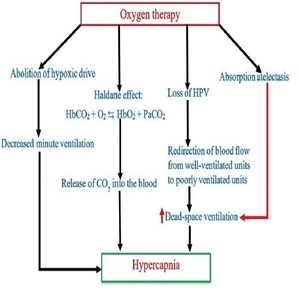Oxygen-induced hypercapnia: physiological mechanisms and clinical implications

Submitted: August 8, 2022
Accepted: October 24, 2022
Published: November 18, 2022
Accepted: October 24, 2022
Abstract Views: 26014
PDF: 6072
Publisher's note
All claims expressed in this article are solely those of the authors and do not necessarily represent those of their affiliated organizations, or those of the publisher, the editors and the reviewers. Any product that may be evaluated in this article or claim that may be made by its manufacturer is not guaranteed or endorsed by the publisher.
All claims expressed in this article are solely those of the authors and do not necessarily represent those of their affiliated organizations, or those of the publisher, the editors and the reviewers. Any product that may be evaluated in this article or claim that may be made by its manufacturer is not guaranteed or endorsed by the publisher.
Similar Articles
- Massimiliano Polastri, Lara Pisani, Andrea Dell'Amore, Stefano Nava, Revolving door respiratory patients: A rehabilitative perspective , Monaldi Archives for Chest Disease: Vol. 87 No. 3 (2017)
- Paolo Ruggeri, Federica Lo Bello, Francesco Nucera, Michele Gaeta, Francesco Monaco, Gaetano Caramori, Giuseppe Girbino, Hereditary hyperhomocysteinemia associated with nephrotic syndrome complicated by artery thrombosis and chronic thromboembolic pulmonary hypertension: A case report , Monaldi Archives for Chest Disease: Vol. 87 No. 3 (2017)
- Abhishekl Agarwal, Sakshi Batra, Rajendra Prasad, Anand Verma, Abdul Q. Jilani, Surya Kant, A study on the prevalence of depression and the severity of depression in patients of chronic obstructive pulmonary disease in a semi-urban Indian population , Monaldi Archives for Chest Disease: Vol. 88 No. 1 (2018)
- Bruno Bordoni, Fabiola Marelli, Bruno Morabito, Beatrice Sacconi, Depression, anxiety and chronic pain in patients with chronic obstructive pulmonary disease: the influence of breath , Monaldi Archives for Chest Disease: Vol. 87 No. 1 (2017)
- M. Malerba, B. Ragnoli, M. Corradi, Non-invasive methods to assess biomarkers of exposure and early stage of pulmonary disease in smoking subjects , Monaldi Archives for Chest Disease: Vol. 69 No. 3 (2008): Pulmonary series
- P. Trerotoli, N. Bartolomeo, A.M. Moretti, Hospitalisation for COPD in Puglia: the role of hospital discharge database to estimate prevalence and incidence , Monaldi Archives for Chest Disease: Vol. 69 No. 3 (2008): Pulmonary series
- G. Caramori, M. Fabbri, D. Paioli, F. Falcone, C. Severino, G. Felisatti, O. Arar, I.M. Adcock, K. Fan Chung, P.J. Barnes, A. Ciaccia, A. Papi, Asthma is not a common cause of severe chronic respiratory failure in non-smokers: ALOT study , Monaldi Archives for Chest Disease: Vol. 63 No. 2 (2005): Pulmonary series
- N. Barbarito, E. De Mattia, Grading the severity of obstruction in patients with Chronic Obstructive Pulmonary Disease and morbid obesity , Monaldi Archives for Chest Disease: Vol. 79 No. 3-4 (2013): Pulmonary series
- Abhijeet Singh, Rajendra Prasad, Rajiv Garg, Surya Kant, Giridhar B. Hosmane, Abhisek Dubey, Abhisek Agarwal, Ram Kishun Verma, A study to estimate prevalence and risk factors of Obstructive Sleep Apnoea Syndrome in a semi-urban Indian population , Monaldi Archives for Chest Disease: Vol. 87 No. 1 (2017)
- Madalina Macrea, Richard ZuWallack, Linda Nici, There’s no place like home: Integrating pulmonary rehabilitation into the home setting , Monaldi Archives for Chest Disease: Vol. 87 No. 2 (2017)
You may also start an advanced similarity search for this article.

 https://doi.org/10.4081/monaldi.2022.2399
https://doi.org/10.4081/monaldi.2022.2399





